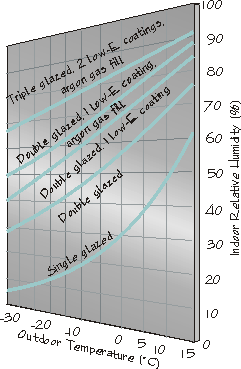
Cam's Carpentry
Quality Building is our Passion
Perth, Ontario
THE COMPLETE SEAL BUILDING SYSTEM
Why "Complete Seal"?
The rigours of a Canadian climate can be very demanding on a home - not only does the building envelope have to repel moisture from without, but during our heating season it must repel moisture in the form of water vapour from within.
Throughout most of the heating season, the air inside our homes has a higher relative humidity than the air outside. This sets up a vapour pressure that can drive water vapour across the exterior walls. Under certain circumstances, that water vapour can condense in the wall cavity as it migrates outwards (see Fig. 1). The colder the outside temperature, the more likely this is to happen. This moisture can get "trapped" in the wall cavity, resulting in possible damage to insulation and framing components. In extreme conditions, mould growth can also occur.
Figure 1
Typically polyethylene vapour barrier is installed on the inside of exterior walls to retard this moisture migration. Unfortunately, poor installation or holes cut for electrical boxes, wiring, etc. can then concentrate the moisture migration in these areas.
That's why we've developed our Complete Seal Building System.
Figures 2 & 3 represent typical details of the Complete Seal Building System. All wiring on exterior walls is kept to the inside of the vapour barrier, virtually eliminating both moisture diffusion into the wall cavity and air infiltration (drafts) into the home.
The interior 2" of styrofoam also helps reduce vapour diffusion and eliminates thermal bridging (heat loss) across the wall studs. The result is an extremely well sealed home that's easy to heat!
Figure 2
Figure 3
Maintaining a constant interior relative humidity (RH) during the winter also becomes easier. At Cam's carpentry, we suggest maintaining your home at a minimum RH of 45% to 50%. This higher level is not only healthier, but helps protect interior finishes, hardwood floors, furniture, etc. which can suffer damage when the RH is low or allowed to fluctuate.
Air Quality & Excessive Moisture
In a well sealed home free of drafts, air quality and excessive moisture can become problems if sufficient fresh air is not introduced into the home. During the summer months, simply opening windows and allowing fresh air to circulate throughout the home addresses these problems. During the heating season however, stale moist air must be exhausted and fresh air introduced with mechanical ventilation. At Cams Carpentry , we use a Heat Recovery Ventilator (HRV) to capture heat from that exhaust air and warm the fresh, cold air being introduced into the home.
To operate the heating, cooling, humidification, ventilation and air quality components of your home effectively and efficiently,Cams carpentry uses the control system - its simply the best solution on the market today for integrating these components.
Window Condensation
Figure 4 illustrates how moist indoor air can condense on a window as the outdoor temperatures drops. The more energy efficient the glazing is, the lower the outdoor temperature can be before condensation occurs.
Remember that we recommend maintaining your home at a minimum of 45% RH - that's why we use double glazed windows with 1 Low E coating, Argon gas fill and warm edge spacers as our minimum standard.
By using this energy efficient glazing, window condensation is virtually eliminated - there are only a handful of days during the winter months in Eastern Ontario when condensation may occur. If condensation does happen, a quick mop up will protect the window finish.



